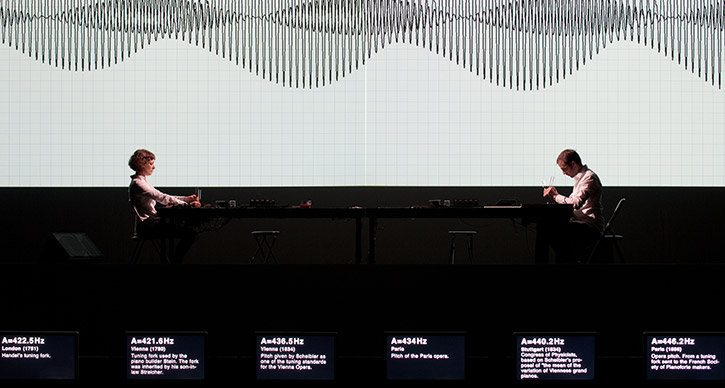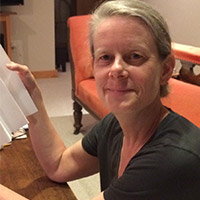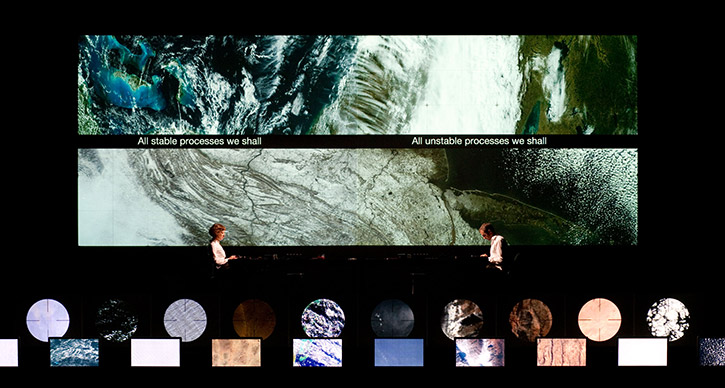Resident Update: Painter Carolyn Reed Barritt on superposition

Moment in superposition. Photo by Kazuo Fukunaga.
 Painter Carolyn Reed Barritt is a UMS Artist in Residence this season. We’ve asked five artists from across disciplines to take “residence” at our performances and to share the work these performances inspire.
Painter Carolyn Reed Barritt is a UMS Artist in Residence this season. We’ve asked five artists from across disciplines to take “residence” at our performances and to share the work these performances inspire.
Carolyn attended Ryoji Ikeda’s superposition on October 31st, 2014. She shares her thoughts on the performance:
“It beings with darkness. Then strobing white lights, blackness, dust and a million pinpoints of data give way to the machinations of observer/operators who elegantly wend their way towards an understanding of the infinite…..Seeing superposition has made me think a lot more about size and about trying to more elegantly depict the tiny as well as the immense. Maybe more importantly, superposition has made me contemplate obscurity, and I realize now, much more than I did before, that there is no need to continually explain everything. Equally, there’s no need to always comprehend. Sometimes it’s enough to just observe and absorb.”
Read the full post on Carolyn’s blog
Interested in learning more? Read our interview with Carolyn.
Artist Interview: Ryoji Ikeda, creator of superposition

Photo: Moment in superposition. Photo by Kazuo Fukunaga.
superposition is a performance created by visual and sound artist Ryoji Ikeda. Inspired by the mathematical notions of quantum mechanics, Ikeda employs a spectacular combination of synchronized video screens, real-time content feeds, digital sound sculptures, and for the first time in Ikeda’s work, human performers.
The work will be premiered at the MET in New York City immediately before it arrives in Ann Arbor on October 31 and November 1.The interview excerpted below is between Ryoji Ikeda and Peter Weibel, and was recorded at ZKM Karlsruhe on July 31, 2012 by Manuel Weber and transcribed by Wolfgang Knapp.
Peter Weibel: First, thank you for the time and opportunity to speak about your work. My first question would be about title: superposition. Are you referring to the quantum mechanical idea or are you referring to the cinema, where you work with superpositions. What is the idea behind the title?
Ryoji Ikeda: I have never specified anything. How did you feel when you heard the word “superposition”? I am very curious about people’s can impressions when they hear “superposition.”
PW: Well, I would think of the wave function of Schrödinger, from quantum mechanics. Then I would think of the super-imposing of image on image, and then I would think of the observer who has a position superior to anything else.
RI: Because you are a very intellectual person. When you hear the word superposition, you are inspired. But, for example, my mother just thinks, “Super! Position!” The word has a very wide spectrum of meanings, and I think that’s good. People can get many meanings. And of course, I am obsessed by that quantum mechanical meaning. And also, the other superposition principle, the fundamental principle of physics. For example, the harmonics that superpose and that make our voice and sound.
superposition performance trailer:
PW: So you are also thinking of musical notations? Of the superimposition of frequencies?
RI: Yes, exactly. But the core topic for me is the quantum mechanical meaning, the fundamental characteristic of quantum physics.
PW: When did you become interested in the quantum nature of reality? And why?
RI: I read some books when I was a student. Of course, it was really difficult and pretty counter-intuitive. But it stunned me to discover quantum mechanics. After that, I became an artist, but it was absolutely impossible to describe quantum mechanics for my art. So, I just make a piece of art. It’s a performing art piece, which never explains quantum mechanics. It is rather inspired by quantum mechanics. Some of the expressions are scientifically correct. I use lots of data sets from NASA and so on, but the construction, the composition is very intuitive because I am an artist. So, it’s hybrid.
PW: I see. I can imagine that when you have to make a decision between the classical world view — that means causality and mechanics — and quantum mechanics, I think that, as an artist, the idea of uncertainty or of many different possible worlds is more attractive. I think all these possible worlds give us — as artists — more freedom.
The people who help you working on the superposition performance – your assistants; are they programmers? Musicians? What is their profession?
RI: They are basically programmers. And architects and all kinds of artists. They are very young, in their twenties. They can program almost in every language. Super.
PW: I have a question for you as an artist. How do you solve the following problem? Morton Feldman, the wonderful American composer, said that music is structure. Normally it is time-based structure. But Feldman disliked most kind of music because it is a slave of time. Rhythm and beat – these things control the music. Time tells music what to do. But Feldman wanted to destroy this control. He wanted music that was not slave to time. How do you solve this problem? Can we create a music that is superior, music that destroys our structure of time?
RI: I really like most of Feldman’s music and his philosophy, but I can’t really follow him. And after John Cage and after that generation, you know, and the generation of computer and programming, my direction is super-precise, it is the direction on “control.”
PW: So, no chance experiments like Cage. Control instead of chance.
RI: I try to control randomness. This is a big counterpoint, the encounter of randomness and control. The contrast is more interesting. If you really control a millisecond, there are other possibilities, even if they are microscopic. You can’t perceive the change directly, but if you pay very close attention, the entire composition changes. So, I try to add randomness, and I like to see the counterpoint, the counterbalance.
PW: Schönberg in his book Style and Harmony stated that the composer’s challenge is to move from one note to the next. You don’t work with notes but with waves, continuous sine waves. A note is a discrete model. As an acoustic artist, how do you see this problem?
RI: Of course, I use sine waves, pure waves, but if you reduce the waveform to its function, this point is very, very tiny and is called the impulse. It is so short that when you listen to such a sample you don’t hear it. The point is what makes the acoustics. Sine waves are continuous, they have no direction. They never contribute to acoustics.
It’s the opposite of white noise, which is random. That’s a different thing, but I use lots of impulse, as you will hear. I’d never use one hundred speakers like [the composer] Stockhausen does. No. Mono! At the center of a church or some very large space, maybe just an impulse on a single mono speaker. That would make you feel the very acoustics spatially through some rich reverb created by that very short impulse.
PW: I see. The acoustics of a wave is a kind of point you…
RI: …you slice.
PW: Exactly.
RI: Any point.
PW: Brilliant idea. So I see that you are now investigating not only a new organisation of sounds but a new series of harmonies on a technical and mathematical basis.
RI: Yes. That is my basic research. This is not really the work of an artist but basic research for basic knowledge to find my language. To develop my alphabet and the grammar is my structure, my music. And I don’t want to use the normal alphabet.
Interested in learning more? See Ryoji Ikeda in Ann Arbor as part of the Penny Stamps Lecture Series and also the Saturday Morning Physics Series. Details on ums.org.
Data as Playful: Sonification Specialist on superposition

Scene from Ryoji Ikeda’s superposition, at Power Center October 31-November 1. Photo by Kazuo Fukunaga.
Robert Alexander is a sonification specialist working with the Solar and Heliospheric Research Group at the University of Michigan, where he is pursuing a PhD in Design Science. He is also collaborating with scientists at NASA Goddard, and using sonification to investigate the sun and the solar winds. We chatted with Robert about his fascinating work last season.
As it happens, Robert is also a big fan of the visual and sound artist Ryoji Ikeda, whose work superposition will be premiered at the MET in New York City immediately before it arrives in Ann Arbor on October 31 and November 1.
Robert chatted with us about what’s special in Ryoji Ikeda’s work, beautiful and playful data, and lion roars in the universe.
UMS: What inspires you about Ryoji Ikeda’s work? What in Ryoji Ikeda’s work influences the way you think about your own work with data sonification?
Robert: Ryoji’s work directly addresses the aesthetics of data. Within Ryoji’s work, we’re not only exploring data as beautiful but also data as playful. Data as immersive. Data as illusory.
He inspires me to think about how I represent scientific data sets. His work conjures the scientific and the precise and plays with these notions of accuracy, and he is very much playing quite often. As a data sonification specialist, I’m aware that I can also play with that balance between scientific representation and appealing directly to the notion of the “wow,” the sublime.
That’s what science can be. It can remind us of the beauty of this universe that we live in, the sublime experience of being alive. And sometimes the scientific representations can potentially sterilize that which may otherwise be enigmatic.
Performance trailer for superposition by Ryoji Ikeda:
UMS: You’ve seen Ryoji Ikeda perform multiple times. Can you tell us about one of those experiences?
Robert Alexander: One initial experience was at the International Conference of Auditory Display in Washington D.C. I had the chance to take in his work up close. He invited everyone up to sit on the stage, and I was sitting a few feet from the projection screen. His work lends itself so well to massive scale. It’s meant to completely absorbed, it’s meant to be immersive.
During this experience I was also captivated by his masterful ability to direct attention. As a composer or film producer, you’re often holding the audience’s attention almost like a tiny baby bird in your hand. You’re cradling the audience’s attention, and if you jar them, then that’s going to pull them out of the experience, but if you don’t provide enough stimulus, they get bored.
I was amazed at Ryoji’s ability to craft an experience such that I never felt pulled out of it. I was continuously pulled deeper into the work, I was continuously searching for deeper levels of meaning.
Spektra by Ryoji Ikeda:
UMS: How would you describe this work to someone who’s not familiar with it, someone who’s never had an experience like this?
Robert: I would probably pull out my phone and put the flash on the strobe function, point it directly at their face, and begin beeping at them [Laughs] I would say that’s about as close as I could get.
One perspective or take that might help someone new to the work is light. So, let’s say we go camping, and when we get there, we turn on our headlamp in the tent. Now we have minimal control of our environment, and yet we still feel that we have an element of modernity, so long as we are able to bring light to the space, even in its most rudimentary form.
When you think about representations of “the future,” be it eastern or western, many of them are ripe with dazzling displays of light, holographic representations.
When you think about Ryoji Ikeda’s work, let your eyes glaze for a moment, and what you’re witnessing is essentially a dance of light. He’s playing with light sculpture quite often, like in his work Spectra in London. He is both invoking this vision of the future, and yet working with just a single, minimal column of light. To truly appreciate this work you need to experience it, to stand beneath the pillar of light that he shot into the sky in this case.
And so, it’s fascinating how he goes about playing with light, but also sound. The auditory tapestry that he weaves, it vibrates with these simple minimal waveforms. We’re not used to the high frequency sounds in his work without those types of sounds signifying something important. We’re used to these beeps signifying a tele-type or a print out or a digital display, and the precision of these sounds coupled with the visual conjures this deeply synesthetic experience.
It’s absolutely hypnotic. I think that’s the way it’s meant to be experienced, as a complete sensory immersion.
UMS: We’re excited to be immersed! We also want to know about your work. What projects are you working on now? Do you have any updates for us since we last chatted last season?
Robert: I am still working very closely with a number of scientists at the NASA Goddard Spaceflight Center. Just recently, we published a case study titled “The Bird’s Ear View of Space Physics.” “The bird ear’s view” is a notion that we’ve used to describe what listening to data can provide. For example, when you listen to a data stream that’s been collected via satellite, you can hear minute fluctuations in something like the solar magnetic field. When you convert that to sound, given the rate of sound file playback, 44,100 data samples per second, we can hear the evolution of this data set across multiple days of real-time recording in just several second of listening, which is rather incredible.
In this case study, we worked closely with a single research scientist. First we introduced this scientist to these techniques of listening to data, and then we tracked how these techniques were integrated into his workflow, the types of observations that were made through listening, and how those observations led to additional formal investigations through visual analysis and through statistical analysis. And so this paper is great in that it covers the complete process for someone who is first introduced to this technique and then ultimately uses it to extract new knowledge from data sets.
Also, there are now many terms in the space research sciences, particularly helio-physics, terms such as “chorus,” “hiss,” “tweets,” “lion roars,” terms for physical phenomena, that have roots within auditory observations. For example, “whistlers” which are essentially results of lightning strikes that can be heard in very low frequency on radio waves, can be heard as this descending whistling sound, so the term “whistler” is now the default nomenclature for this phenomenon. It originally came about through just listening to the data, it’s an acoustic description. And then there are “lion roars.” Again, researchers were listening to a data set and they heard kind of a low “Grr” sound, like a low roar of a lion an the Serengeti [laughs], and that term has now stuck. It’s been really fascinating to work with research scientists, to play them some of their data sets and actually see the epiphany moment as their gears turn, and they say, “Aha!, that’s why we call it a ‘lion roar.’” [Laughs]
UMS: This all must be incredibly rewarding for you, to see your work receive this kind of support?
Robert: It’s been unbelievably rewarding to work alongside these research scientists and some of the brightest minds in the world and to be able to help provide a fresh perspective to these data sets, and also to provide them with the knowledge and infrastructure to apply these technique on their own. And that’s ultimately the goal, to enable the scientific community at large to adopt the practice of listening. It has been and continues to be an incredible experience.
Interested in learning more? See Ryoji Ikeda in Ann Arbor as part of the Penny Stamps Lecture Series and also the Saturday Morning Physics Series. Details on ums.org.


